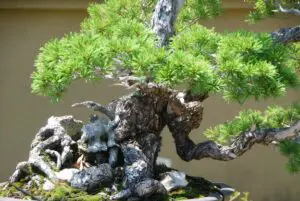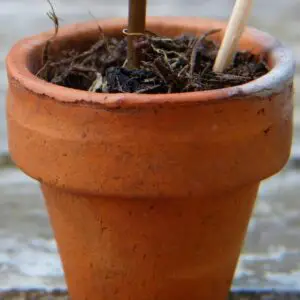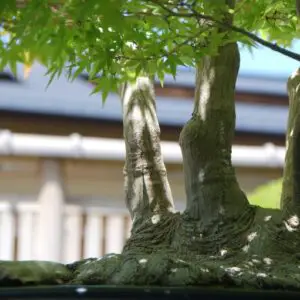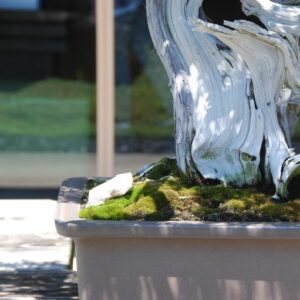If you are wondering whether you should use a bonsai training pot or a normal pot, here is the main purpose of using them.
One of the main purposes of using the bonsai training pots is to adapt the root system to a training pot with a small rooting volume so that the training tree will be ready to be potted in the shallow bonsai pot when the training process is done.
What is bonsai training?
Before answering why to use bonsai training pots, you should know what is bonsai and why we need to train a tree to be a bonsai tree. Here is a brief explanation.
What is Bonsai?

Bonsai is the Art of Miniature Landscape: a natural landscape created with plants in a bonsai pot. It is not just a small tree planted in a pot but rather the tree, the soil, the moss and everything in it are to be regarded as the reflection of nature’s beauty.
In order to make a tree a “bonsai”, you have to design the style of the tree, its placement in the pot, and the balance and the harmony between the style of the tree and the shape of the pot.
What does training a bonsai tree mean?

Japanese maple trees in training
Training a bonsai tree entails the process of designing an ordinary tree to be one that symbolically reflects a natural landscape by certain techniques such as growing in shallow pots, pruning, wiring and defoliating.
Training a bonsai tree takes a couple of years to more than a few decades depending on the species, styling and the size of the tree. The training process has several stages.
If you want to know how bonsai trees stay small, please check the following post. There are cool scientific reasons for it!
What is bonsai training pots for?
What is the purpose of the bonsai training pots?

Training pot
The purpose of bonsai training pots is to nurture a tree to become a bonsai, the art of miniature landscape. This includes adapting the root system to a training pot with a small rooting volume so that the training tree will be ready to be potted in the shallow bonsai pot when the training process is done.
Restricting the root system in a small pot has the benefit of making the trunk, branches and leaves of a tree become smaller than planting it in the ground. This is one of the techniques, besides wiring and defoliation, to make a normal tree a miniature bonsai tree.
What kind of pots are best suited for bonsai training pots?

The requirements for bonsai training pots
Besides being shallow, bonsai training pots should meet some criteria to achieve the desired bonsai style.
In order for bonsai training trees to grow soundly, the shape and quality of the pots must be suitable for the physiology of the plants. This means the training pots should be able to retain water yet remove the excess from the pot, give the roots sufficient fresh air, especially oxygen, and warm the roots to some extent.
If the pot lacks these requirements, the roots will rot, causing the tree to die.
The requirements for the bonsai training pots are;
- the depth is much shallower than usual pots;
- the material of the pots is porous;
- they have drainage holes of appropriate size and number at the bottom;
- they have good drainage and air circulation capabilities; and
- they have some water retention ability as well.
Clay pots are the best bonsai training pots
As mentioned earlier, there are several stages in the bonsai training process and the type of the pot may be altered. Clay pots can be used throughout the bonsai training process, which can be replaced by stoneware pots at a later stage.
| Type | Aeration | Drainage | Water-retention | Glaze |
| Clay | High | High | Low | Unglazed |
| Stoneware | Mid-Low | Mid-Low | High | Unglazed |
Clay pots

clay pot
Since the goal of training pots is to grow bonsai trees soundly, it is more important to have conditions suitable for tree growth than how they look in the pots.
An ordinary clay pot is the closest to the ideal as bonsai training pots in terms of its structure, performance, and price. Clay pots have good aeration, drainage and adequate water retention, in addition to their heat absorption and dissipation ability which has a good effect on the root growth.
One major drawback with clay pots is that the frequency and the timing of watering will be difficult. Because the air and water flow in and out of the pots too well, the soil in clay pots can dry out very quickly. They are also a little bit more fragile than porcelain pots.
Talking about porcelain, porcelain pots look better and have good water retention ability and durability, but they have poor airflow and drainage. Porcelain pots can actually obstruct the growth of your training tree and are not suitable for training pots. They should only be used when the tree is fully grown and ready as the bonsai tree.
Why are clay pots suitable for bonsai training?
Clay pots are fired at low temperatures, usually below 1000 degrees celsius. When the material is fired at relatively low temperatures, it hardens enough but remains porous and thus brittle. This porous nature gives them excellent aeration and drainage, favorable conditions for the growth of bonsai.
Also, the price is much more affordable as they are mass-produced in factories.
Stoneware pots

Tokoname stoneware pot
After training for several years, the tree can be viewed as a nearly completed bonsai, though not a perfect one. In this later stage, some pots like stoneware pots that look good on bonsai trees can be used.
Stoneware is a kind of pottery which has the characteristics of both earthenware (=clay) and porcelain. Stoneware bonsai pots are in fact slightly different from stoneware, which is by definition non-porous and water impermeable; stoneware bonsai pots are somewhat porous and do have some aeration and water absorption ability.
Stoneware bonsai pots are fired between 1100 to 1250 degrees celsius and are harder than clay pots. When tapped, they produce a clear high-pitched tone. As the silicic acid in the raw material melts during firing, they are shinier than the clay pots.
It comes in a variety of colors depending on the composition of the raw material; red, purple, black, blue, and white. It is known to have a calm beauty and go well with the dark green leaves of coniferous trees.
Tokoname is very well known for manufacturing stoneware bonsai pots as well as Shigaraki and Yokkaichi.
Can I use plastic training pots?
Plastic training pots may be used at the very first stage of bonsai training like gemination but bonsai trees cannot grow well if you continue to use them.
The roots must have sufficient air and moisture in order for a tree to grow soundly. As plastic does not allow air and water to go through, roots cannot get enough air, and the soil can be either too wet or too dry.




